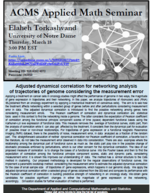Elaheh Torkashvand
University of Notre Dame
3:00 PM (EDT)
Zoom Link:
https://notredame.zoom.us/j/95942524572?pwd=K1Zqb0JnL29CVzZWdDJFc0pCd3FsUT09
Meeting ID: 959 4252 4572
Passcode: 585010
Title: Adjusted dynamical correlation for networking analysis of trajectories of genome considering the measurement error
Abstract: Applying a treatment on cancer cells in oncology studies might affect the performance of genome in two ways, the magnitude of gene expression in trajectories and their networking. In this paper, we analyze trajectories of ribonucleic acid (RNA) \BL{obtained from an oncology experiment by applying a mechanical treatment on cancerous cells}. The aim is to see how the treatment affects networking within a selected group of genes before and after perturbations considering measurement error in data. The adjusted dynamical correlation is introduced to find the possible networking among genes here considering measurement errors. The Pearson coefficient of correlation and dynamical correlation are statistical tools used in this context to find the networking inside a genome. The latter considers the expectation of Pearson coefficient of correlation among the functional principle component scores of time (space) dependent functional bases using the Karhunen-Lo\`eve expression of functional data. This measure removes the average of functional curves, static part, from the analysis of correlation while it can also get affected by the treatment. It considers then the dynamical part for evaluation of possible linear or non-linear relationships. For trajectories of gene expression or a functional Magnetic Resonance Imaging (fMRI) dataset, there is the possibility of noise, measurement error, in data analyzed as a fraction of the random part. The straightforward calculation of neither dynamical correlation nor Pearson coefficient of correlation, a favorite tool in the literature, do not take the measurement error observed in data into consideration. There are also examples where the relationship among the dynamical part of functional curve as much as the static part play role in the possible change of stochastic processes enforced by perturbations, which is our other concern for the dynamical correlation. The idea of our proposed measure of correlation is to change the bases of a functional curve into the Fourier bases and then to find the expectation of correlation among the functional principle component scores, static and dynamic parts, considering measurement error. It is shown this improves our understanding of data. The method has a similar structure to the Cats method in clustering. Our proposed methodology is developed for the regular observations of functional curves. We implement a parametric bootstrap method considering the measurement error to estimate the adjusted dynamical correlation for the case of small sample size of trajectories of gene expressions, which happens in our genomic study. We apply the adjusted dynamical correlation within a selected group of genes obtained from the $t$-test and compare its performance with the Pearson coefficient of correlation in building predictive strength of networking in an oncology study. We obtain gene candidates for possible significant changes in either the magnitude of gene expression or the networking, accordingly. Simulation studies for further evaluation of method is performed.
